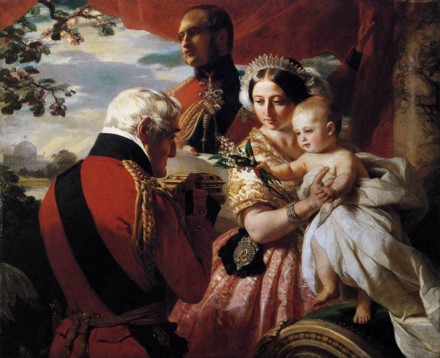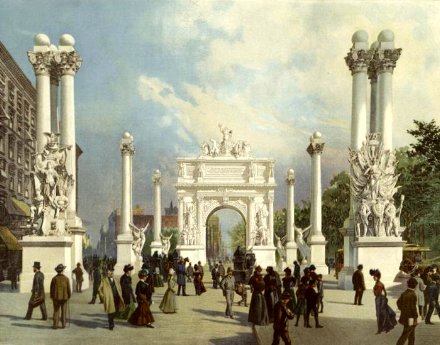Tradition
About Andrew Cusack
 Writer, web designer, etc.; born in New York; educated in Argentina, Scotland, and South Africa; now based in London.
Writer, web designer, etc.; born in New York; educated in Argentina, Scotland, and South Africa; now based in London. read more
News
Blogs
Reviews & Periodicals
Arts & Design
World
France
Mitteleuropa
Knickerbockers
Argentina
The Levant
Africa
Cape of Good Hope
Netherlands
Scandinavia
Québec
India
Muscovy
Germany
Academica
Gabriel García Moreno
Ecuador’s Saintly President
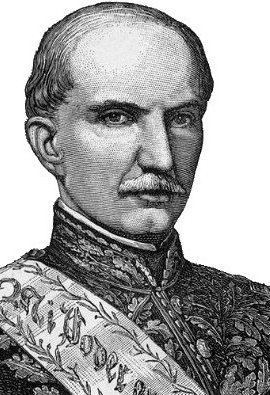
WE LIVE IN an age which is almost completely devoid of Christian statesmen. In their stead, we are today ruled by faceless bureaucrats and vapid masters of spin. Gentlemen once sought public office in the hopes of ensuring order and the public good while dark and knavish men sought the same in their lust for power. The politicians of today, meanwhile, tend to be of neither inspiration but rather seem all too often to have engaged upon the ‘career’ of ‘public servant’ because they lack any of the skills necessary to succeed in any real, productive employ, station, or vocation. Given the sad state of affairs in our day, we must look to the past — to another age and indeed another continent — in our search for models of Christian leadership in the temporal realm of a modern republic. In this search, the name of the journalist, scholar, statesman, and saint, President GABRIEL GARCÍA MORENO of Ecuador, stands taller than any other in the Americas. (more…)
The Great Seal of Carolina
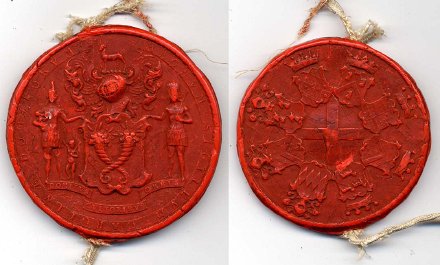
THE ROYAL CHARTER which erected the Province of Carolina created the colony as a county palatine, similar to Durham, Chester, and Lancashire back in England. However, instead of being ruled by a Count Palatine (or Prince-Bishop in Durham’s case), Carolina, named after England’s martyr-king Charles I, was to be ruled by eight Lords Proprietor, the eldest of which would hold the title of Lord Palatine of Carolina. The charter even allowed for the granting of titles…
…to Men well deserving the same Degrees to bear, and with such Titles to be Honoured and adorned, AND WHEREAS by our form of Government It was by our said Predecessor Established and Constituted, and is by us and our Heires and Successors for ever to be observed, That there be a certain Number of Landgraves and Cassiques who may be and are the perpetual and Hereditary Nobles and Peers of our said Province of Carolina, and to the End that above Rule and Order of Honor may be Established and Settled in our Said Province.
The granting of the titles of ‘landgrave’ and ‘cassique’ never really took off, but the Lords Proprietor did have a rather splendid Great Seal for their own private fiefdom in the New World, an impression of which is happily preserved by the good people of the South Carolina Department of Archives and History down in the Palmetto State.
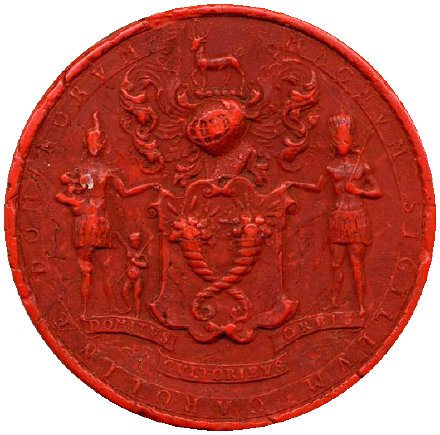
The obverse (above) shows the arms of the Province of Carolina with two cornucopias in saltire. Joseph McMillan, Director of Education for the American Heraldry Society, has posited that this is the probable origin of the cornucopia depicted in the Great Seal of the State of North Carolina, the larger of the two Carolinas. The motto reads “Domitus Cuitoribus Orbis” which perhaps some learned reader could translate properly. The reverse (below) depicts the eight heraldic shields of the Lords Proprieter, surrounding a simple Cross of Saint George. Some readers may recall this configuration being used, in a much simplified form, in the heraldic achievement recently devised by the College of Arms for the Senate of North Carolina, mentioned and depicted previously on this site. The arms of the North Carolinian Senate also show the cornucopias in saltire in the crest above the shield.
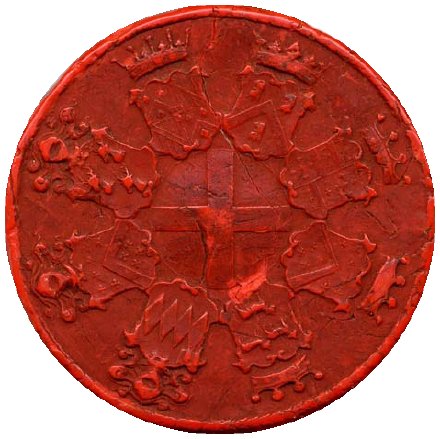
UPDATE:
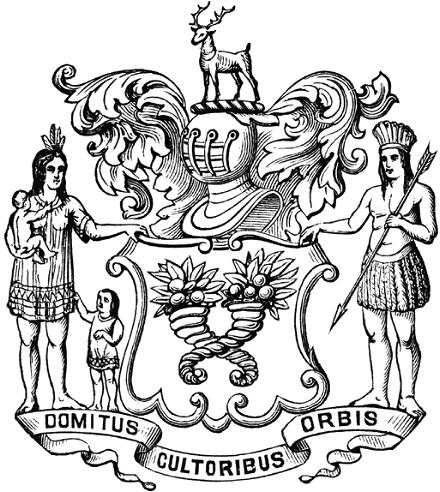
The commenter below is correct; the motto is ‘Domitus Cultoribus Orbis’ or ‘Tamed by the Husbandmen (cultivators) of the World’, as shown clearly in this alternate depiction which I have discovered.
Stauffenberg’s Arms
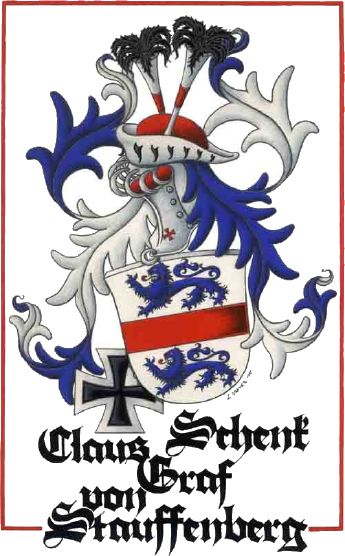
Hommage à la mémoire de Claus Philip Maria Schenk comte von Stauffenberg, homme d’honneur et de foi, qui participa à l’attentat contre Hitler, le 20 juillet 1944 dans le cadre du plan ‘Walkyrie’ destiné à renverser le régime nazi.
The arms of Claus Philipp Maria Schenk Count von Stauffenberg, beautifully depicted by the French heraldic artist Laurent Granier.

Previously: Long Live Our Holy Germany!
Monarchs and Presidents in Islam
National Review, Nov 21, 1986
by Erik von Kuehnelt-Leddihn
IN THE Islamic world’s relations with Israel, the hard-liners are the various Arab and non-Arab republics. When there is any sign of softness, it comes, almost always, from one of the monarchies. (Egypt, and Egypt alone, is the exception.) It thus did not come as a great surprise that King Hassan II of Morocco agreed to meet with the then Israeli prime minister, Shimon Peres, this summer.
While individual monarchs historically may have been capricious or cruel, monarch as an institution is inclined to be generous: Montesquieu has told us that while the driving element in republics is virtue, in monarchies it is clemency. And, indeed, the Islamic monarchs of old were infinitely more tolerant than their modern republican successors. They traveled extensively, and many had a cosmopolitan outlook. Some had relatives abroad. When King Hassan II of morocco writes to members of Europe’s royal families, he addresses them as “cher cousin” or “chere cousine,” since he is a descendant of Mohammed’s daughter Fatima, as by now are all the Christian royal families. (Many centuries ago, a Moroccan prince was taken prisoner by the Castilians and converted in captivity. After his release he married into a princely family, and over the centuries his bloodline has spread into countless aristocratic and royal families.) In chooing their administrators, officers, diplomats, bankers, and doctors, Islam’s monarchs looked for able men regardless of religion, never caring whether their choices were popular or not.
It is true that local slaughters of Christians took place in various parts of the Turkish Empire, but things got really bad only when the enlightened, highly nationalistic Young Turks appeared on the scene. Their political organization was called “Unity and Progress,” by which they meant ethnic uniformity and modern methods. It was they who were behind the big Armenian massacres during World War I. The Turkish sultans, by contrast, frequently gave preferment to Christians (and sometimes Jews) in high positions. The Phanariotic Greeks, so called after the Lighthouse Quarter of Constantinople in which most of them lived, acted as trusted administrators; the governors of the Rumanian-speaking provinces, for instance, were taken from their families.
Very typical is the story of a family known to me. Originally called Black, they were Scots and good Catholics who emigrated after the fall of the Stuarts and settled in France, where they Gallicized their name. There are still Blacques in France, but one branch of the family emigrated to Turkey, where its scions made a splendid career without changing either their name or their religion. One of them, Edward Blacque-Bey, became the last Turkish imperial ambassador in Washington. (His sons, too, made diplomatic careers. One married an American, and his son, having graduated from Harvard, became a colonel in the U.S. Marines and later an American diplomat.) Edward Blacque-Bey wore a fez and was a loyal subject of the sultan, under whom Constantinople became an international metropolis. All this ended with the republic under Ataturk.
Similar conditions existed in the kingdom of Egypt before Nagib and Nasser. Forty per cent of the administrators and civil servants were Coptic Christians, who considered themselves the genuine descendants of the Old Egyptians. Before 1952 Cairo was an eastern Paris, where Christians and Jews played an important role–socially, commercially, politically, Arab nationalism put an end to all this, not only in Cairo, but also in Alexandria, which is so well described in Lawrence Durrell’s Alexandria Quartet. In Iran–a non-Arab state–the old monarcy under the Kajar dynasty and the more recent one under the Pahlavis were notably tolerant. Non-Muslims (such as the still-surviving Zoroastrians) could make all sorts of careers, and the country’s political orientation was Western. The window to the West remains open in the Islamic monarchies of today–in Morocco, in Saudi Arabia, in Oman, and even in Malaysia.
MONARCHIES HAVE the advantage that, although they might be oppressive toward the political ambitions of their subjects, they are never totalitarian. To my knowledge there is no Jewish community left in Algeria, but there still is a small one in Morocco. Variety is the keynote of monarchies, and with it goes internationalism. In 1910 only two sovereign nations in Christian Europe had truly native dynasties: Serbia and Montenegor. (Peter III was the last genuine Romanov; the Hohenzollerns were not Prussians but Swabians; and so forth.) These dynasties could often follow unpopular policies, both domestic and foreign. Popular policies are not always good for the country, and the courage required to stick to an unpopular good policy is immensely rare among politicians in democracies. They crave popularity and want, above all, to be re-elected. King Hassan II might be trembling lest he be assassinated by fanatics, but he pursues policies that he considers to be right. He certainly is not guided by Sir Henry Campbell-Bannerman’s idiotic dictum, “Self-government is better than good government,” which is roughly equivalent to saying that self-treatment in case of illness is better than treatment by a qualified physician.
New York in Philately
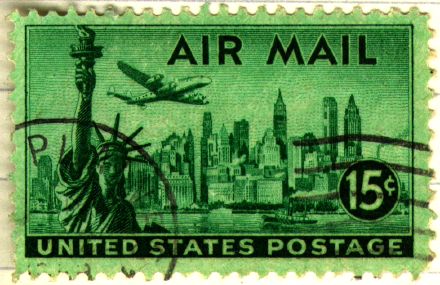
Wandering around the merry old world wide web I stumbled upon these stamps, which I bring to you for your own enjoyment. Above we have the Great Metropolis itself, the island of Manhattan in its swankier days. Below we have a view of the Crown of the Hudson, West Point, with the beautiful Cadet Chapel designed by that American Master, Bertram Grosvenor Goodhue himself, presiding over the campus of the United States Military Academy.
The postage stamp was once a thing of beauty and composition, but it’s heartening to see that some still design beautiful stamps. Just examine Elliott Banfield’s stamp of General Washington, based upon the staute in Union Square. Mr. Banfield believes that the decline in the design of postage stamps is due to a “moral void” most readily shown when the Postal Service unveiled its famous ‘Elvis Stamp’ a few years back.
“Elvis was important in the popular culture, yes,” writes Mr. Banfield. “But how important is the pop culture? Important only to those who can’t see anything higher or better. It’s scary to think that people like that are in charge of public policy. But they are, and the Elvis stamp proves it.”
Hear! Hear!
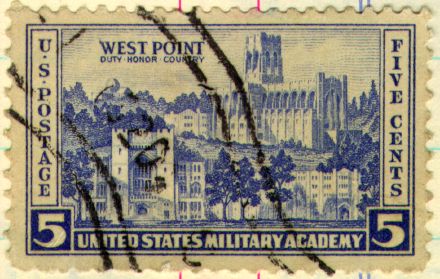
An irrelevant stamp, after the jump.
A Royal Gathering
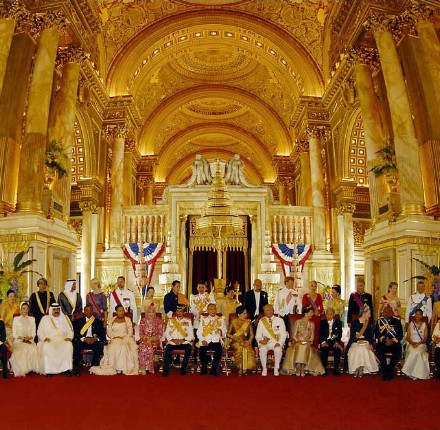
Click here for a photo of most of the world’s reigning monarchs and a number of other royalty, gathered to celebrate the jubilee of the King of Thailand’s accession to the throne.
A few weeks ago, Fr. Rutler informed me that the Queen of Thailand, upon acceding to the throne, made a vow never to perspire. No word on whether she’s kept her vow.
An Old Military Academy on Long Island
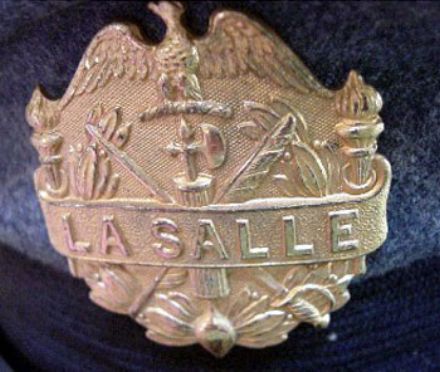
EDUCATION HAS BEEN one of the long-standing traditions of the Christian faith, as has service, and what better expression of education and service is there than the Catholic military school. La Salle Military Academy in Oakdale, L.I. was just one of these institutions, founded by the de la Salle Christian Brothers in 1883. The school was actually founded here in Westchester as the Westchester Institute, but moved in 1926 to Indian Neck Hall on Long Island, built by F.G. Bourne (whose upsate shack was Singer Castle on Dark Island) and once one of the largest estates on the Island. The main building was a 110-room mansion overlooking Great South Bay, designed by Ernest Flagg who, coincidentally, was responsible much of the Naval Academy at Annapolis including the great chapel which contains the tomb of John Paul Jones, sometime admiral of the United States and Imperial Russian navies. (more…)
Marshal Foch and the Old Guard
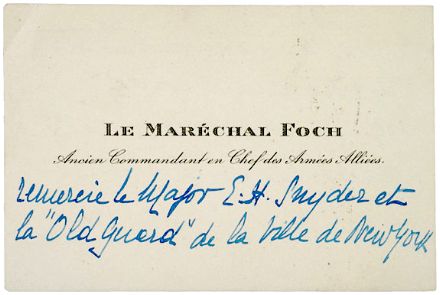
This calling card of Marshal Ferdinand Foch, Supreme Allied Commander during the First World War, was for sale in November of 2005. The text reads Le Maréchal Foch, Ancien Commandant en Chef des Armées Alliées, remercie le Major E.H. Snyder et la “Old Guard” de la Ville de New York or, in English, “Marshal Foch, Former Commander in Chief of the Allied Armies, thanks Major E.H. Snyder and the Old Guard of the City of New York”.
Previously: A New York Funeral | Old Guardsmen | The Old Guard | Grandpa
The Veteran Corps of Artillery
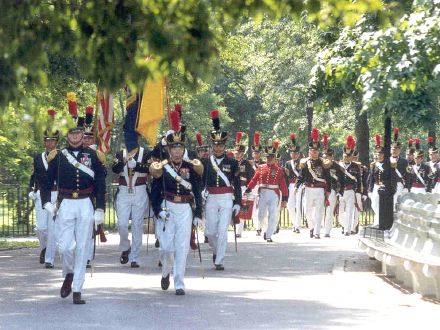
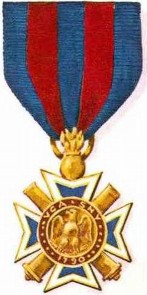 I PROMISED MYSELF I’d wake up this 4th of July morning and head down to the Battery for the annual Independence Day artillery salute by the Veteran Corps of Artillery. However, the gods of slumber ordained that I remain in bed asleep and so in recompense I thought I’d bring you, dear readers, an informative post about the Corps itself. While this site has featured a fair amount on the Old Guard we mustn’t let our readers be mistaken that we are somehow ignoring the VCA. After all, the Veteran Corps of Artillery, State of New York, founded in 1790, is more senior to the Old Guard, founded in 1826 (though in fact an amalgamation of the two older militia companies, if I recall correctly). While there is more of the Old Guard available from online research, I am more familiar with the VCA owing to my Uncle Matt’s membership thereof. And of course, like the Old Guard, the VCA operates on a seperate ranking structure, so that one could be a Major General in the Army, National Guard, or New York Guard, and yet be a mere private in the Veteran Corps of Artillery. (more…)
I PROMISED MYSELF I’d wake up this 4th of July morning and head down to the Battery for the annual Independence Day artillery salute by the Veteran Corps of Artillery. However, the gods of slumber ordained that I remain in bed asleep and so in recompense I thought I’d bring you, dear readers, an informative post about the Corps itself. While this site has featured a fair amount on the Old Guard we mustn’t let our readers be mistaken that we are somehow ignoring the VCA. After all, the Veteran Corps of Artillery, State of New York, founded in 1790, is more senior to the Old Guard, founded in 1826 (though in fact an amalgamation of the two older militia companies, if I recall correctly). While there is more of the Old Guard available from online research, I am more familiar with the VCA owing to my Uncle Matt’s membership thereof. And of course, like the Old Guard, the VCA operates on a seperate ranking structure, so that one could be a Major General in the Army, National Guard, or New York Guard, and yet be a mere private in the Veteran Corps of Artillery. (more…)
Major General Lord Monckton of Brenchley, 1915-2006
Knight Grand Cross of Obedience of the Order of Malta
Maj-Gen the 2nd Viscount Monckton of Brenchley, who has died aged 90, was awarded an MC in 1940 and later became director of Army public relations at a time when the Armed Forces’ public profile was growing in importance.
At 50 he retired early to run his 350-acre farm in Kent and to join the boards of a series of firms to help pay for the education of his five children. In the House of Lords he became a persistent critic of the neglect of rural and military interests, and took a lifelong interest in archaeology and water divining.
The sole Roman Catholic trustee of a £3 million appeal for Canterbury Cathedral in 1974, Monckton was president of the British Association of the Sovereign Order of Malta, and helped to ease strained relations with its Anglican counterpart, the Venerable Order of St John of Jerusalem, by taking part in ecumenical services.
He also played a key role in forming the Order of Malta Volunteers, who aid the sick at the shrine of Lourdes, and in setting up trust care homes with the Venerable Order.
The Royal Scots Dragoon Guards
The 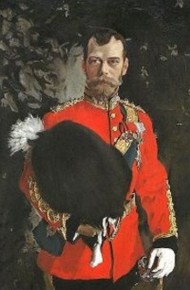 Royal Scots Dragoon Guards (Carabiniers and Greys), to give its full name, is a rather interesting outfit, being Scotland’s only cavalry regiment and indeed the senior Scottish regiment in the entire British Army. The oldest antecedents of the regiment date back to the late 1600s, though it only took its current form as SCOTS DG (the official abbreviation) in 1971. The unit’s cap badge displays the French Imperial Eagle captured by the Scots Greys (the main antecedent of the current regiment) at Waterloo. More interestingly, however, is that the cap badge is always, even to this day, worn on a black facing, in mourning for Czar Nicholas II.
Royal Scots Dragoon Guards (Carabiniers and Greys), to give its full name, is a rather interesting outfit, being Scotland’s only cavalry regiment and indeed the senior Scottish regiment in the entire British Army. The oldest antecedents of the regiment date back to the late 1600s, though it only took its current form as SCOTS DG (the official abbreviation) in 1971. The unit’s cap badge displays the French Imperial Eagle captured by the Scots Greys (the main antecedent of the current regiment) at Waterloo. More interestingly, however, is that the cap badge is always, even to this day, worn on a black facing, in mourning for Czar Nicholas II.
The Czar was Colonel-in-Chief of the Scots Greys from 1894 until his grizly murder at the hands of the Bolsheviks. Indeed, at regimental dinners at which the band is present, ‘God Save the Czar’, the old Russian Imperial Anthem, is still played in memory of His Imperial Majesty and his family. In 1998, the Commanding Officer and a regimental party were present at the interrment of the Czar’s remains in St. Petersburg. The Czar is pictured above in his uniform as Colonel-in-Chief of the regiment. Unique amongst the British cavalry regiments, the full dress uniform of the Royal Scots Dragoon Guards includes the bearskin cap, a privilege inherited from the Scots Greys.
The Scots Greys were also the subject of one of Lady Elizabeth Butler’s great paintings, ‘Scotland Forever!’ (below, and in larger form here), depicting their charge at the Battle of Waterloo in 1815 and further described here by our own Man About Mayfair. Of course, the fact which we have no doubt will bring even greater reknown to the Royal Scots Dragoon Guards is its privilege of counting the great William Calderhead, M.A. (Hons), St Andrews 2004, among its officers.
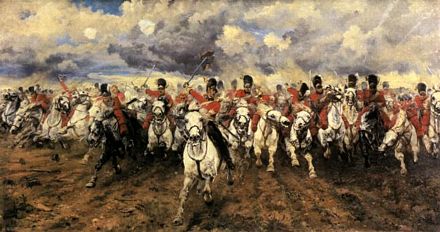
The Perils of Over-Restoration
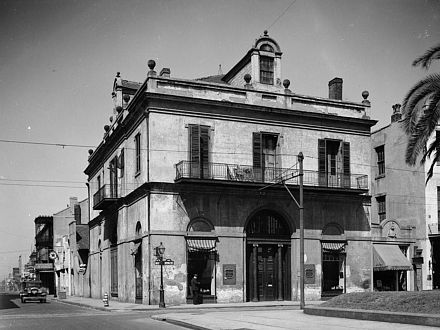
A rather good article I was reading in the Oxford American (via V&V) reminded me of a building I stumbled upon in the Historic American Buildings Survey, digitized at the Library of Congress. No. 403 Royal Street in the French Quarter of New Orleans was designed by one of the first master architects in America, Benjamin Latrobe, who also designed the Baltimore Basilica, the Mother Church of the United States. Resting at the corner of Royal and Conti streets, the building was constructed by the Louisiana State Bank (later subsumed into la Banque de la Louisiane) and features a domed banking hall in the center. After having outlived its usefulness under its original purpose, it became a private residence, with the central banking hall turned into a living room, before being turned into an events venue as it remains today. (more…)
Some New York Coinage
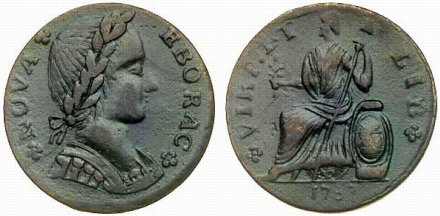
IT MAY INTEREST our readers to know that before the Feddle Gummint started throwing its weight around, the Great State of New York was in the habit of minting its own coinage. One of the most famous of the coins produced during the era is the 1787 ‘Nova Eborac’, so called for its abbreviation of Nova Eboracum; that’s ‘New York’ in the language of our ancient Roman forbearers.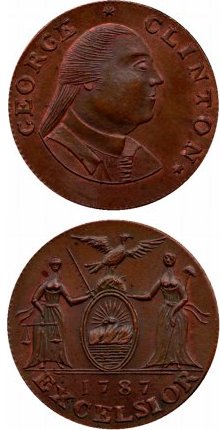 All decent people being lovers of monarchy, the New Yorkers of yore found themselves in a slight predicament. Their king had granted them independence four years earlier, but George III (the forgetful man!) neglected to indicate who would be king once he relinquished the sacred office. Every country must have a king — if not, then whose face would go on coins and such? “Not to worry,” saith the designer of the Nova Eborac. “We’ll stick a king on and just not say who he is.” And so they did, as seen on the obverse of the above Nova Eborac. The reverse depicts a figure who looks suspiciously like the Britannia on the old British coins. Old habits die hard. Around this Britannia-esque figure is the inscription VIRT. ET LIB for Virtus et Libertas – Virtue and Liberty.
All decent people being lovers of monarchy, the New Yorkers of yore found themselves in a slight predicament. Their king had granted them independence four years earlier, but George III (the forgetful man!) neglected to indicate who would be king once he relinquished the sacred office. Every country must have a king — if not, then whose face would go on coins and such? “Not to worry,” saith the designer of the Nova Eborac. “We’ll stick a king on and just not say who he is.” And so they did, as seen on the obverse of the above Nova Eborac. The reverse depicts a figure who looks suspiciously like the Britannia on the old British coins. Old habits die hard. Around this Britannia-esque figure is the inscription VIRT. ET LIB for Virtus et Libertas – Virtue and Liberty.
One Thomas Machin, however, clearly thought this was a bit silly and so decided to simply put the Governor on the coins he produced. His coins (seen on the right) show Gov. George Clinton on the obverse and a depiction of the arms of the Empire State on the reverse (they also grace the banner of this webpage). A chap named Ephraim Brasher went a little further and depicted neither the anony-king nor the governor but instead put depictions of heraldic arms on both side of the coin; New York on the obverse and the United States on the reverse. These coins are known as ‘Brasher’s Dubloons’ and the front and back can be seen below.
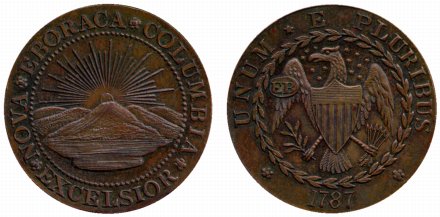
Previously: New York Currency
A New York Funeral
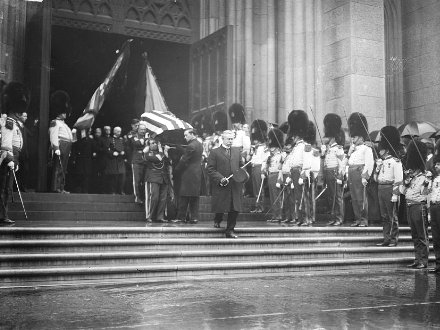
These photos are from the funeral procession of Gen. Daniel Sickles in 1914. Above, the General’s coffin leaves St. Patrick’s Cathedral. Below, the procession down an avenue (I can’t tell which one), eventually to be transported to Washington and buried at Arlington National Cemetery. The Old Guard of the City of New York provides the Guard of Honor.
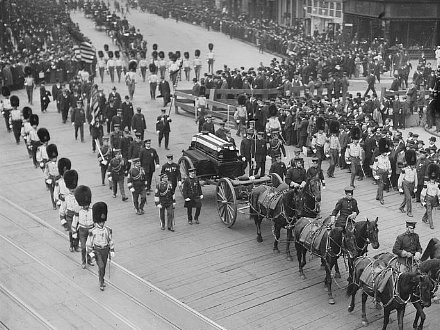
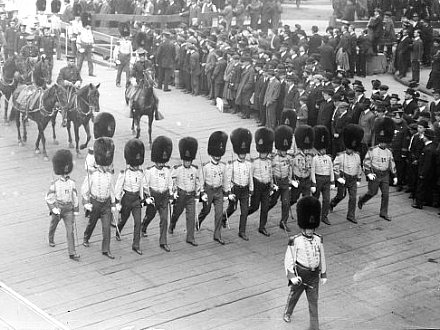
Previously: Old Guardsmen | The Old Guard | Grandpa
‘Voltaire’s Castle’ Up For Sale
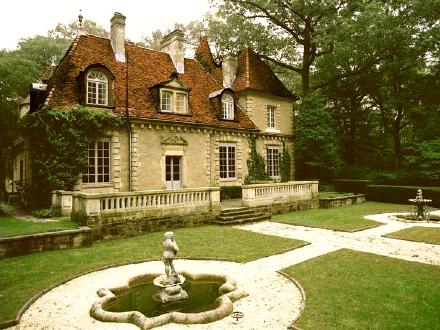
Want to live in a French philosophe’s petit chateau but don’t want to put up with high taxes, soaring unemployment, and immigrant neighborhoods in a permanent state of rebellion? Then boy have I got the house for you! The seventeenth-century Château des Thons, which tradition claims is where the dastardly ‘Enlightenment’ thinker Voltaire carried out his affair with Madame de Chatelet, was shipped during the 1920’s to the peaceful village of Upper Brookville, L.I. in the Great State of New York and is currently on the market. The house features Louis XIV panelling, a sweeping staircase, a tower, and a good few fireplaces.
One of my favorite Voltaire anecdotes is his confident claim – hilarious in hindsight – that “One hundred years from my day there will not be a Bible in the earth except one that is looked upon by an antiquarian curiosity seeker.” Two hundred and twenty eight years after his death, the Bible is still a best-seller and the most widely-read book in the world.
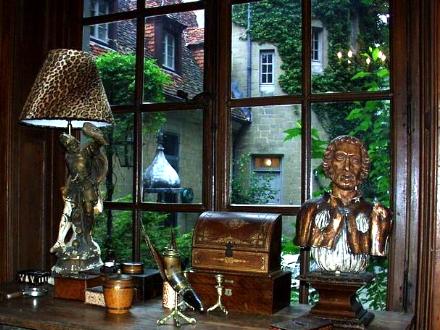
Clerics of the Old School
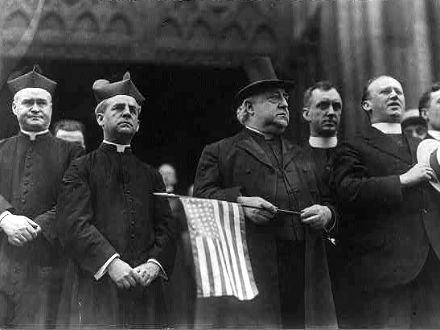
Msgr. Lavelle and others review the 69th N.Y. Regiment from the steps of St. Patrick’s Cathedral, 21 June 1916.
Previously: Your Royal Highness, Caed Mile Failte | Fighting 69th: Home for St. Patrick’s Day
Words of Wisdom
I’d like to thank Field Marshal Rommel for vindicating my life.
Recent American Heraldry
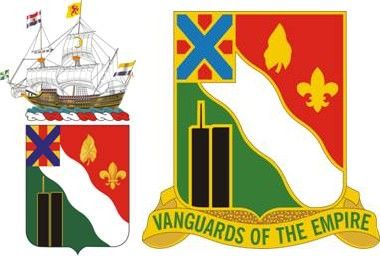
The Army Institute of Heraldry on 7 April 2006 approved a new coat-of-arms (left) and Distinctive Unit Insignia (right) for the 104th Military Police Battalion. According to the information provided by TIOH (as the Institute goes by), the red in the shield represents the unit’s role as a Field Artillery Battalion during World War II, while the green signifies the military police. The taro leaf represents the unit’s service in Hawai’i during the Spanish-American War, while the fleur-de-lis stands for service in France during both World Wars.
The black silhouette of the World Trade Center, a unique heraldic innovation, honors members of the unit who died in the Twin Towers on September 11, as well as the members of the battalion deployed to Manhattan. The service of earlier component units are represented in the canton. The red cross of St George symbolizes the War of Independence, while the blue saltire of St Andrew (akin to that of the Confederate battle flag) symbolizes the Civil War.
In blazonry, the language of heraldry, the shield is “per bend Gules and Vert, a bend wavy Argent, to chief a taro leaf and fleur-de-lis in bend Or; issuing from base the silhouette of the Twin Towers Sable edged of the fourth; on a canton of the last a cross Gules surmounted by a saltire Azure”. The crest is that which is standard to all New York Army National Guard units, depicting the Halve Maen on which Hudson explored New York harbor and his eponymous river. It is blazoned “from a wreath Argent and Gules, the full rigged ship “Half Moon” all Proper”.
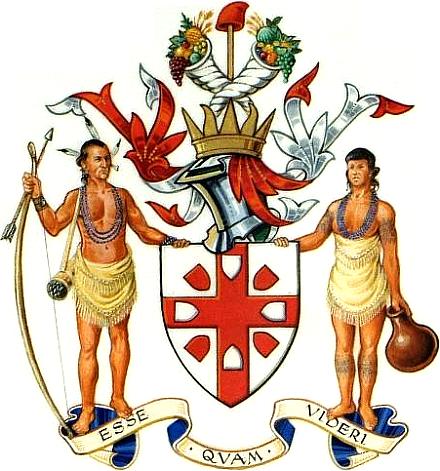
Meanwhile, the President of the Senate of North Carolina petitioned the College of Arms in London for a coat of arms for the upper house of the state legislature. The devisal by Letters Patent of Arms, Crest, and Supporters was made 25 November 2005 by Garter, Clarenceux, and Norroy and Ulster Kings of Arms. The eight little shields (known as escutcheons in blazonry) on the main shield allude to the eight proprietary Lords of the Province of Carolina. The colonial grant for Carolina was one of the most feudal, allowing the Lords of Carolina to grant minor hereditary titles of nobility, and in terms of heraldry allowed for the appointment of a Carolina Herald to grant arms independently of the College of Arms in England. The noble coronet atop the shield is apparently one of the heraldic ornaments worked out in 1705 for landgraves and cassiques in the Province of Carolina.
The shield of the coat of arms of the Senate of North Carolina is blazoned as “Argent on a Cross between four Escutcheons bases inwards Gules four Escutcheons bases also inwards Argent” while the crest is “Issuant from a Coronet of a Noble of the former Province of Carolina Or a Cap of Liberty Gules raised upon a Pole Or between two Cornucopiae in saltire Argent replenished proper”. The supporters are “On each side an Aborigine of North Carolina as depicted by John White in the reign of Queen Elizabeth the First that on the dexter a Warrior supporting with his exterior hand a Long Bow and holding an Arrow girded at his back a Quiver that on the sinister a Woman holding in her exterior hand a Gourd all proper”.
An interesting note: the lower house of North Carolina’s General Assembly was known as the House of Commons until the conquest of the South during the Civil War.
Images from the United States Army Institute of Heraldry and the College of Arms respectively.
Search
Instagram: @andcusack
Click here for my Instagram photos.Most Recent Posts
- Amsterdam November 26, 2024
- Silver Jubilee November 21, 2024
- Articles of Note: 11 November 2024 November 11, 2024
- Why do you read? November 5, 2024
- India November 4, 2024
Most Recent Comments
- on The Catholic Apostolic Church, Edinburgh
- on Articles of Note: 11 November 2024
- on Articles of Note: 11 November 2024
- on Why do you read?
- on Why do you read?
- on University Nicknames in South Africa
- on The Situation at St Andrews
- on An Aldermanian Skyscraper
- on Equality
- on Rough Notes of Kinderhook
Book Wishlist
Monthly Archives
Categories

